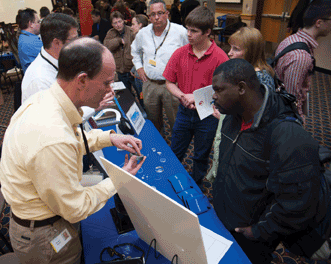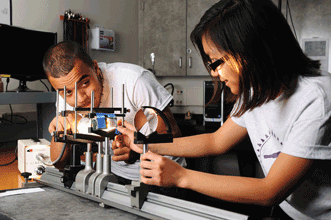The success of the Monroe Community College optics program is a stellar example of industry support and involvement, including cash and material donations and direct student support. While some companies just wring their hands and complain that colleges aren’t producing the workforce they need, the Rochester-area employers offer a shining example of how industry and education can – and must – work together for the benefit of both. Kudos to them!
– Judy Donnelly, column editor
What do you call a community college with the oldest associate degree program in optical systems technology in the U.S., enthusiastic industry supporters, an ambitious marketing plan, plus dormitories? A number of individuals close to the program would like you to call it a national resource for the optics industry.

More than 600 high school and college students, parents and job seekers attended the 2014 High-Tech Exploration Night at Monroe Community College in Rochester, N.Y., to learn about degree programs and high-tech careers and to meet with local employers, including eight optics companies.
Monroe Community College, in Rochester, N.Y., launched its optical systems technology program in 1971, and today it offers both an A.A.S. degree and a certificate. While enrollment has risen and fallen over the years, in good economies and bad, the past five or six years have seen strong growth, thanks in large part to a strong and well-executed plan focused on engaging industry partners and program investments. The number of students in the program quadrupled from 11 in the fall semester of 2008 to 48 in the fall of 2013. The program was going strong this fall, too, with 43 students.
As might be expected, many students in the program graduate with job offers in hand, while others go on after graduating from MCC to earn bachelor’s degrees in optics. One notable graduate, Jim Sydor, graduated from the program in the early 1970s and eventually took the helm at Stefan Sydor Optics, in Rochester. He is a strong supporter of the MCC program.
“It is a great two-year program – and a tool to help you climb the ladder,” said Sydor. “For the local Rochester industry, it is a great resource.”
Sydor Optics employs 10 graduates of the program, including Jim, with the most recent program graduates hired joining the company in 2014. Sydor maintains strong ties to the college, participating along with other companies’ representatives on the program advisory committee and providing input on the curriculum. He is part of the group working to reinvigorate the program today. Others include Mark Pastorella, director of development for the MCC Foundation; Tom Battley, executive director of New York Photonics and a member of the program’s advisory board; and Rick Nasca, a manufacturing associate at Corning Inc. The four were eager to talk about the work being done to modernize and rebuild the program.
Sydor remembers the days when West Coast companies used to fly in and interview MCC students, echoing the idea that MCC should be considered a national resource. He pointed out that the school has dorms and that, with New York’s reasonable out-of-state tuition, a company could afford to send workers there for a couple of years.
“The energized program may give us more graduates than we can handle locally,” Sydor said. “That’s kind of a classy problem to have.”
At one time, the program relied on contract training for employees from Eastman Kodak Co., Xerox Corp. and Bausch & Lomb Inc. Now, spinoffs from the “Big Three” have created new workforce demands.
“For every optical engineer, you probably need four to five technicians,” said Battley. He and others felt it was important to engage a recognizable company to support their ideas for growing the program. When the opportunity arose, that idea, along with the strong message that workforce development is serious, became part of a discussion with Corning.
Nasca said that the new efforts to build the program have had extraordinary support from Corning. Conversations about MCC’s plan with someone in a high-level manufacturing position there – a believer in STEM education – led to the backing of upper management. That support brought 26 people from Corning’s Fairport plant into the program.
Concurrent with those efforts, and at the request of physics teachers, said Battley, MCC started a summer program sponsored by the Rochester photonics cluster and MCC. The success of the program begged the question of why physics and optics couldn’t be taught together at high school.
That thinking led to a dual-credit program between MCC and several Monroe County high schools that allows students to take an optics course in high school for which they earn college credit through MCC. As a result, many students who take the high school course do enroll at MCC, and the program is being extended to more high schools.
Building for the future
The efforts of MCC and the MCC Foundation to rebuild and fortify New York state’s supply of skilled optics workers, in response to industry demand, began in 2011.
The MCC Foundation is active in building and maintaining key relationships with business and industry partners that help the college build a strong optics workforce pipeline. “The optics industry cares deeply about MCC’s program and has played a key role in revitalizing the program through their strategic and philanthropic investments,” Pastorella said.
In a 2013 report to the industry, “Building an Optics Pipeline,” the MCC Foundation reported a 186 percent increase in fall enrollment since 2007-2008 and an anticipated enrollment increase of 122 percent over the previous year in the dual-credit optics course offered at two area high schools.
Also in 2013, Corning Incorporated Foundation made a $500,000 gift to the program that, along with a $250,000 gift from alumnus Sydor, helped buy equipment for the optics lab that more closely matches what is currently used in the industry. Additional financial support from Corning Incorporated Foundation, Xerox Foundation, Harris Corporation, Citizens Bank Foundation and M&T Bank helps optics students meet the tuition costs and helps inspire others to take a look at careers in optics.
Further, in-kind contributions from several companies have enhanced the optics laboratory. More than $86,000 in equipment contributions came from Advanced Glass Industries, Corning Inc., JML Optical, Optimax Systems, Sydor Optics and Universal Photonics.
At about this time last year, MCC embarked upon a months-long calendar of community awareness and recruiting efforts aimed at building interest in its program, collaborating not just with local schools but also with businesses, industry groups, local agencies and more. The events included:
January 29 – MCC hosted Vice President Joe Biden and wife Dr. Jill Biden, who highlighted the critical role community colleges play in preparing job seekers for high-demand, advanced manufacturing careers.
March 19 – High-Tech Exploration Night allowed high school and current MCC students, parents and other community members to explore MCC technology programs, meet with employers and learn about careers in local high-tech companies.
April 2 – MCC students and alumni learned about local career opportunities in optics and met with job recruiters at a campus forum.
May 6 – A daylong community conversation on the theme “Closing the Skills Gap: Challenges and Opportunities for Higher Education” featured national education experts, along with local employers, educators and Rochester’s mayor discussing the state of middle-skill jobs.
August 21-23 – Summer Optics Sizzler, a multiday career exploration program, challenged high school students to design experiments and explore career paths in optics and local college degree programs. High school students attending also toured advanced manufacturing companies, including Stefan Sydor Optics and Optimax Systems Inc., as well as Monroe Community College’s optics labs and the Corning Museum of Glass.

Carlos Gracia and Tawi Mang adjust lenses on a lens bench to capture the sharpest image as part of an experiment at the Summer Optics Sizzler camp.
Events such as those held last year raised awareness about the region’s skills gap and glut of unfilled jobs. According to Javier Ayala, Ph.D., Dean of Career Technical Education at MCC, key outcomes from those events include a “notable interest among students, families, high school teachers and job seekers in learning more about the educational pathways to high-demand, high-tech careers in optics.” He said that over 600 people attended the High-Tech Exploration Night last March to meet with local employers, including eight optics companies.
“Enrollment in the optical systems technology program remains strong, and efforts are under way to engage more high school students and underemployed/displaced workers in STEM education and training in 2015,” Ayala said.
In addition, The Corning Incorporated Foundation renewed its efforts to provide scholarships to students and to help MCC increase the number of optics educators through investment in an Optics Teaching Academy.
Within the past year, Ayala said, the optics lab curriculum has been redesigned to reflect new lab equipment, some of which was donated or purchased with financial support from employers. The Corning Incorporated Foundation Scholarship in Optics Excellence helped defray the cost of tuition and fees for 39 MCC and dual-enrollment optics students. In addition, the college has been working with the Superior Group to assist MCC optics students with job leads.
MCC recently acquired two new CNC machines from OptiPro Systems. “The addition of new equipment takes the program to the next level and should significantly increase employability of our graduates,” said Ayala. “When one looks at the program, they will get the traditional approaches to optics but also be ready for a 21st century workforce.”
Looking ahead
This spring, a new MCC-led project will hit the road in mobile simulation labs. The SkillBuild mobile labs were designed to introduce advanced manufacturing, health care, skilled trades and applied STEM education as career paths to students from local middle and high schools. The project was designed for replication across the country.
The four rolling labs, built into 18- and 24-foot trailers, will provide career exploration by simulating aspects of the real-world work environments. Basic capabilities of the labs include satellite Internet connectivity for creating Wi-Fi hot spots, onboard generators, laptops and an array of learning kits: Snap Circuits, Lego Mindstorm robots, Erector sets, 3-D printers and more.
In the meantime, the effort to continue building the optics pipeline for the Rochester area and the entire country will keep rolling along. See the box on page 93 for some of MCC’s 2015 goals for continuing to grow the program.
To learn more about working with Monroe Community College to build a stronger optics workforce pipeline, contact:
Mark Pastorella
Monroe Community College Foundation
Damon City Campus
228 East Main Street
Rochester, NY 14604
(585) 262-1500
[email protected]
Building an optical systems technology program
For 2015, MCC has a few key goals in place for continuing to build its optical systems technology program. Some examples include the following:
• Create and implement an Optics Teaching Academy: MCC seeks to increase the number of local high schools that offer an introductory course in optics by providing high school teachers with the tools and knowledge to teach it. Establishing a teaching academy would increase the number of high school students exposed to optics and help expand enrollment in the MCC optics program.
• Identify additional Corning Incorporated Foundation scholarship candidates: 20 scholarships will be available to assist students interested in enrolling in MCC’s optical systems technology program.
• Purchase accessories for existing equipment: In early 2014, Zygo Corp. donated an interferometer to MCC’s optical systems technology program. This integral piece of equipment has enhanced the program curriculum and enriched the student experience, but additional accessories are needed for it to meet industry standards.
• Increase the number of faculty in MCC’s optics program, who will play a vital role in developing and enhancing collaborations with optics employers and higher education institutions.